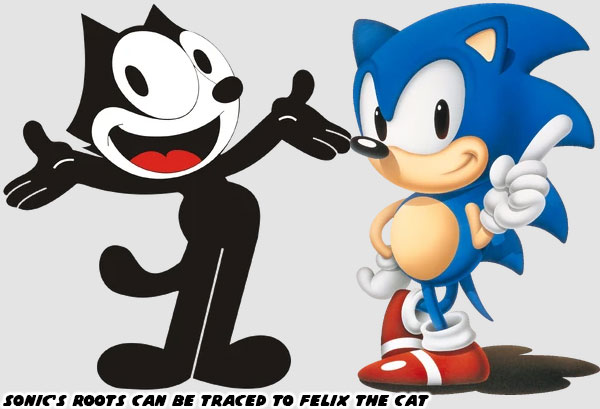
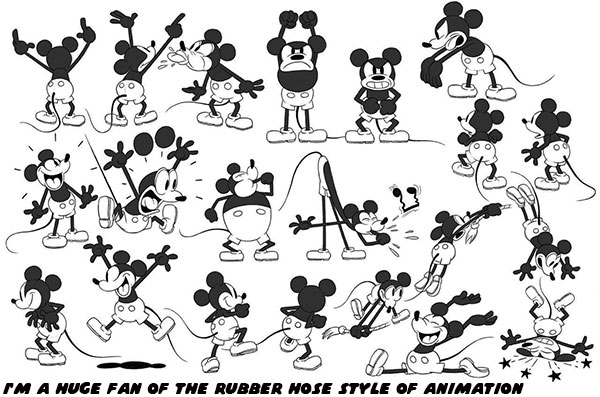
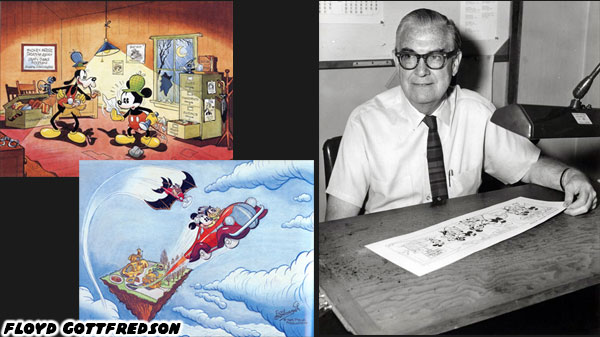
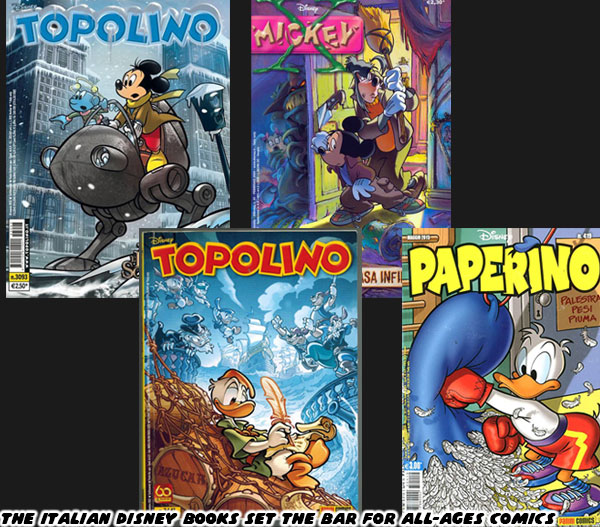

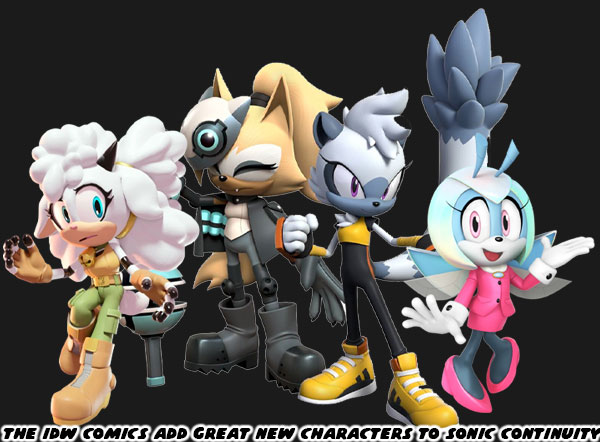
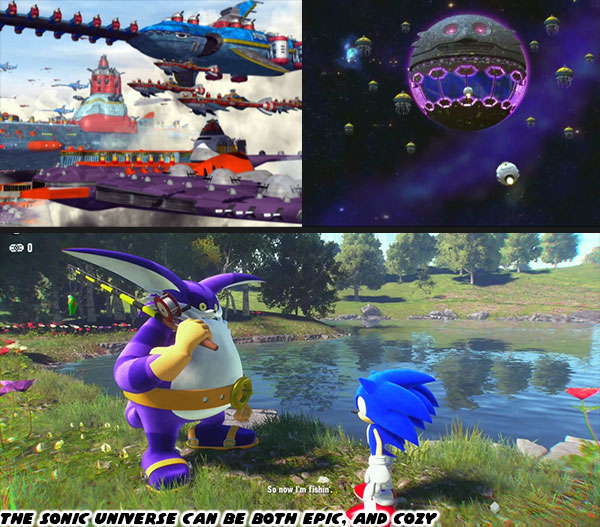
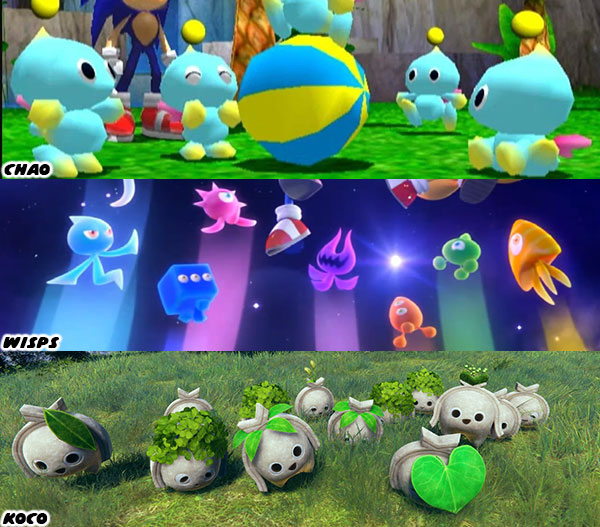
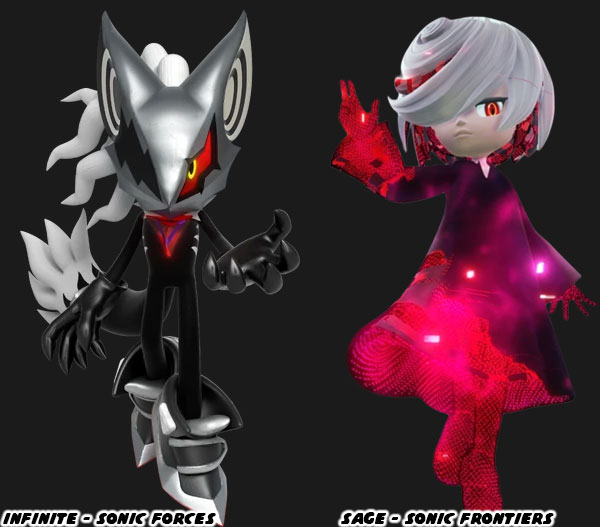
A blog about my interests, mainly the history of fighting games. I also talk about animation, comic books, car culture, and art. Co-host of the Pink Monorail Podcast. Contributor to MiceChat, and Jim Hill Media. Former blogger on the old 1UP community site, and Capcom-Unity as well.









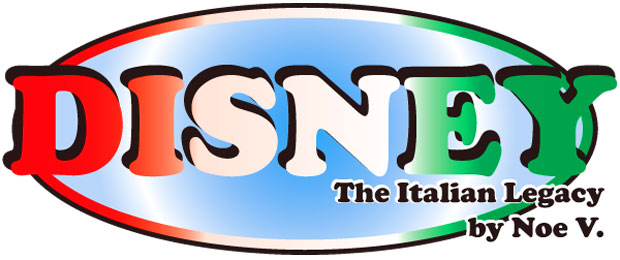
In the previous blogs I had mentioned how some issues of Topolino came with gadgets, or toys for subscribers. Subscribers had to assemble the larger toys. The scale and attention to detail in some of the gadgets were amazing For example a catamaran for Paperino was about 8-inches long, actually floated and had a tiny electric motor to propel it forward. It had sails, a tiny canvas net and figure of Paperino could be removed. The on / off switch for the motor was activated by the steering wheel of the ship.
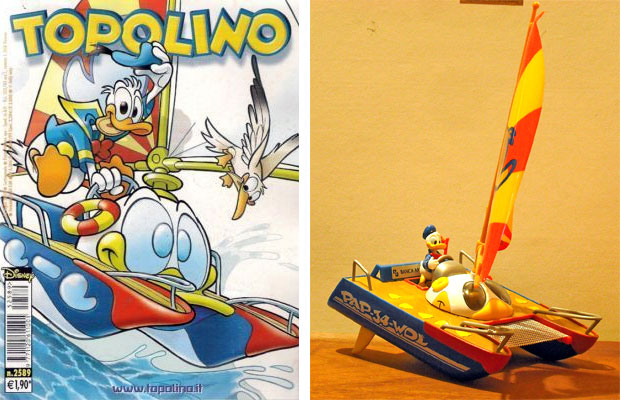
Topolino gadgets included firetrucks, snowmobiles, space ships, motorcycles, castles, dragons, pirate ships and even buildings. Each set was finely produced and was layered with detail and hidden surprises. Even the car gadgets were anything but typical.
The Phantom Blot was the major villain for Mickey Mouse in both US and Italian comics. He often was seen driving around in a mysterious black convertible with a dark blot over the license plate. The car (the Blackmobile or Blotmobile depending on the writer) that could be assembled with the issues of Topolino was a work of art.
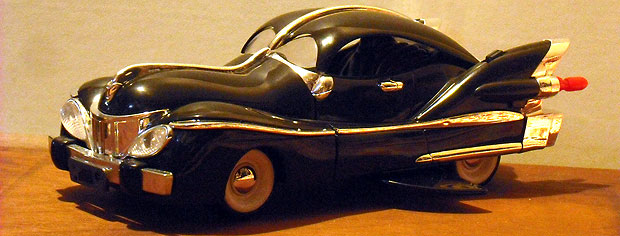
The top of the car could be removed as well as the Phantom Blot figure that came with it. The gear shifter on the car triggered wings on the underside of the car to pop out. A button behind each tail fin of the car shot out red plastic taillight missiles. A button behind the driver dropped plastic oil slick cutouts from the trunk.
These gadgets were unavailable in toy stores, they could only be gotten through subscriptions to Topolino magazine. They helped build fans of the Disney name but also helped build a collectable market. One of the other publishers aware of this trend was De Agostini, also based in Italy. De Agostini held several publishing licenses in Italy, including those for Hokuto No Ken / Fist of the North Star and Dragon Ball. They released DVD sets and collectable plastic figures for many of their licenses.
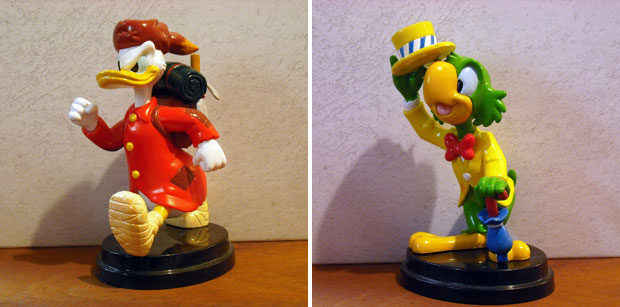
For Disney fans De Agostini released the Disney Parade series. These were hard plastic figures based on characters featured in film and comic books. Figures that would be considered rare in the USA appeared in the lineup, such as a young Scrooge McDuck in his Klondike outfit, or Jose Carioca from Brazil.
The detail in each sculpt was amazing. The coloring and poses were spot on, as if the heroes and villains were taken right from the pages of the comics.
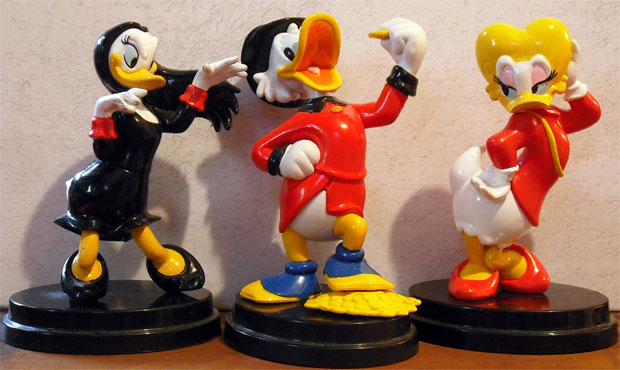
Look at how Magica DeSpell was ready to cast a hex on Scrooge or the flirty look from Brigitta MacBridge. Of course Scrooge seemed fixated on his true love. These figures were not available in stores or online. Collectors had to go to De Agostini kiosks in local malls to collect the figures, two of which were released every week over the course of several months. Imagine how patient fans were that collected a complete set of the 60 figures! Goofy or Pippo as he was known in Italy was given a werewolf alter-ego in the X Mickey comic series. De Agostini was catering the collection to Disney fans that were familiar with storylines featured within the pages of Topolino magazine and the offshoot publications. The white-furred Pipwolf was given the colors and proportions based on the comic but was still kept in scale with the icon that inspired him

The figures were about 4.5 inches on average and each one released was to scale with the rest of the series. Taller characters like Goofy or Mortimer Mouse were pushing 7 inches while shorter characters like Louie or Paperotto (young Donald) were just over 3 inches.
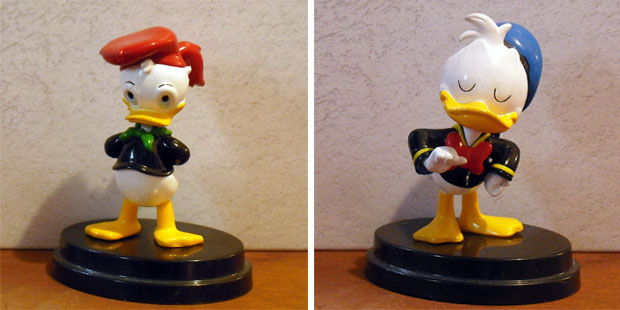
The Disney Parade figures were not all heroes however. Even villains like Rockerduck and the mad scientist Emil Eagle were presented in the set.
Legendary Disney animator Marc Davis would teach his students that a great character designs did not feature characters with blank stares, instead the artist would make it clear that they were living, thinking figures. In the case of the De Agostini sculpts audiences could clearly see that the characters were thinking. The frustration that Rockerduck held while he was chewing on his hat, or that Emil was in the middle of hatching a diabolical plan were apparent.
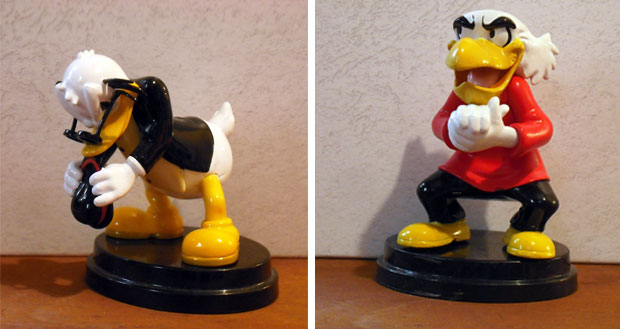
The female leads were not ignored in the collection either. Emily Quackfaster, the secretary for Scrooge and Daisy Duck also made for very interesting figures and poses.
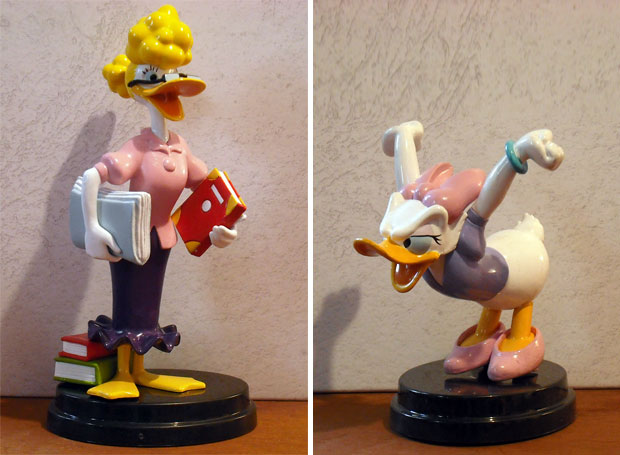
Not many Disney fans in the US were familiar with Donald Duck’s neighbor Mr. Jones. Unless audiences had kept pace with the comics they would have missed out on some of Carl Barks most hilarious short stories. Donald and Neighbor Jones had been the worst of neighbors for almost 70 years, always trying to put the other person in their place. The two characters turned out to be evenly matched despite their size difference.
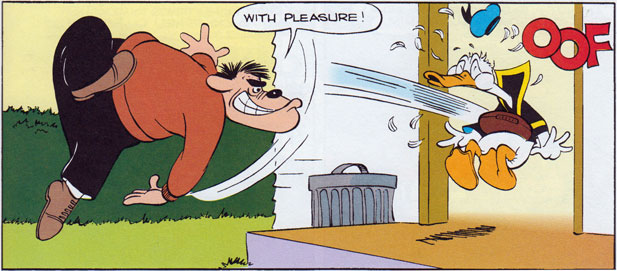
De Agostini allowed the long running feud to finally be recreated in 3D. The figure of Jones was practically daring Donald to take his best shot. Of course one of the Donald figures created by De Agostini was posed ready for a fight as well.
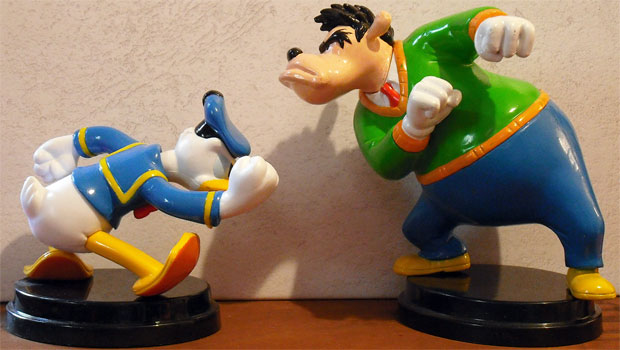
Even after Carl Barks retired the talented Don Rosa kept the two battling in comics. Don ensured that new generations of Disney comic fans would never forget the bitter rivalry. Neighbor Jones did not come up as often in the pages of Topolino but De Agostini knew that collectors throughout Europe would be happy to see and pick up the figure.
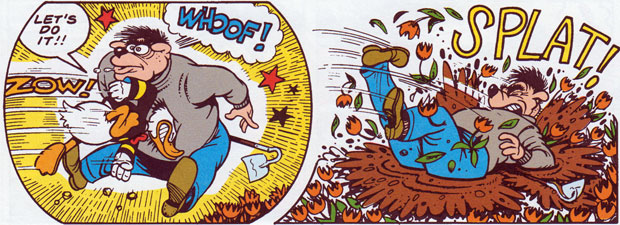
It seemed that almost every character that had appeared in a Disney animated short or on the comic book pages got the Disney Parade treatment. Moby Duck and Fethry Duck made for two very whimsical figures and fit very well with the rest of the collection.

The Disney Parade set was so popular among collectors that De Agostini decided to follow up with a sort of deluxe edition of their figures. The newer ones would be in a larger scale, ceramic and painted with greater detail and fidelity.
The new edition of figures was dubbed the Disney Collection and the sizes now averaged around 6 inches. To distinguish them from the Disney Parade series the new figures were much heavier and placed on larger silver stands. These figures were also made with a smaller run, making them more collectable.
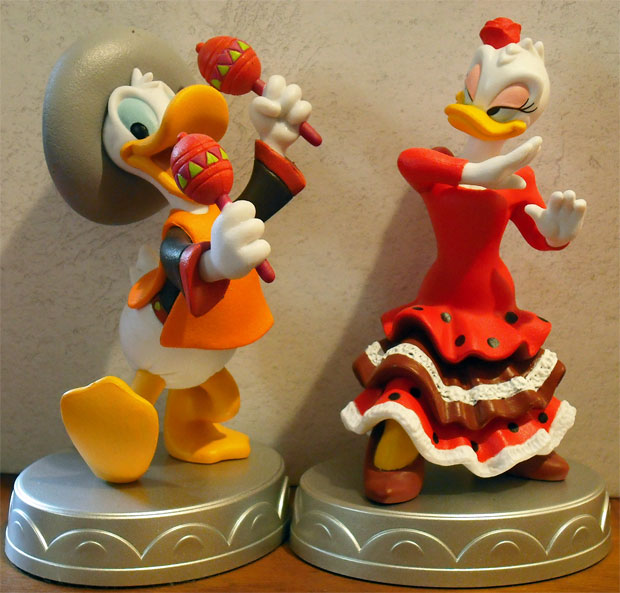
Not all of the characters featured in the Disney Parade made it into the Disney Collection. Those figures that did were given new poses and additional material. Some figures created for the Collection were not featured in the Parade series. The next blog will highlight my favorite figure and try to explain why these collectables were important to the community. As always if you would like to sponsor me please visit my Patreon page and consider donating each month, even as little as $1 would help make better blogs and even podcasts!

The Italians were noteworthy not solely for creating new interpretations of classic characters like Paperinik and Paperotto, but also for diverging from USA Disney canon. For example, in the USA the character of John D. Rockerduck was introduced once by Carl Barks into the Uncle Scrooge adventure the Boat Busters to help push along a plot. Rockerduck was a fellow business tycoon and he challenged McDuck to a race to find out who sold the better gasoline. Donald Duck won the race on behalf of Scrooge but was unfortunately using Rockerduck’s gasoline. In the USA the character would not be seen again save for a cameo in a “Life and Times” story by Don Rosa. Most Disney fans in the USA would recognize that Flintheart Glomgold was the older character, meant to be business rival and mortal enemy of Scrooge McDuck. Yet even Scrooge McDuck was also once meant as a one-shot character in the Bark’s universe. It was not until the character was revisited and fleshed out that he became a comic icon. In Italy and in other European stories John Rockerduck would be brought back and fleshed out as well.
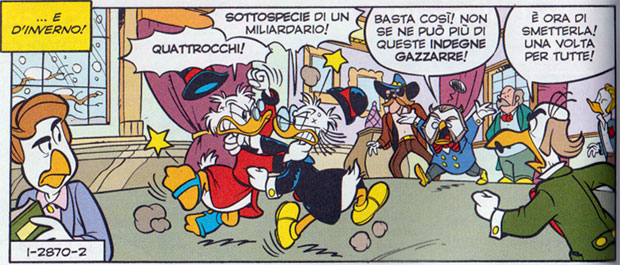
Rockerduck instead of Glomgold would take a starring role against Scrooge. The design and appearance of the character was in fact meant to balance out Scrooge more than Glomgold. Visually Rockerduck’s suit, hat, tie, glasses and sideburns were more contemporary than Scrooge’s. Rockerduck was a brash younger tycoon that did not seem to value his wealth in the same way as McDuck. His fortune was handed down by his father Howard Rockerduck, a self-made business man that helped mentor a young Scrooge decades earlier. John Rockerduck had a different approach to his business empire than Scrooge did. He believed that it took spending money in order to make money, whereas Scrooge was a notorious hoarder and penny pincher. In the comics the ducks rarely got along and were constantly getting into fights while trying to prove who was the superior businessman.
To settle things in fumetti both ducks often had a wager, this part of canon was preserved from the original Barks story. The bet was rarely over money but instead prestige in the clubs for which both ducks were members of. The loser for most of the contests had to eat their own hat. Rockerduck was often presented chewing on the brim of his bowler hat, if not for the contest bet then because he was completely fed up with Scrooge.

As if one powerful tycoon rival was not enough for the pages of Topolino, a second was added shortly after Rockerduck. The Italian Marco Rota added Brigitta MacBridge to canon in 1960. Similarly to Rockerduck and Scrooge she was originally introduced to help push along a single story. She turned out to be a memorable character and would return again and again to drive Scrooge mad.
In canon she was an old acquaintance of Scrooge and was absolutely crazy about him. She was also good friends with Daisy Duck and would often cross paths with Donald and his uncle. She was convinced that the two were meant to be together. As a self made business tycoon she was clearly not in it for Scrooge’s money either.
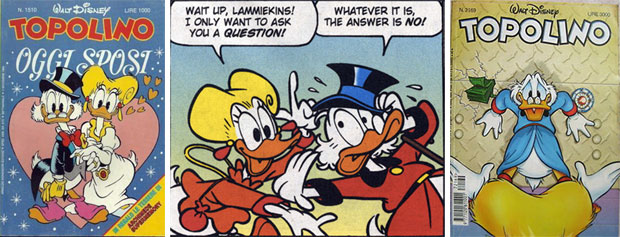
Brigitta would often hatch a plot to try to get Scrooge to confess his feelings for her, or worse, to trick him into getting married. This character seemed to balance out the Rockerduck dynamic. Both were constantly trying to undo Scrooge for their own gain. Both had enormous fortunes so that they could keep up with Scrooge no matter where he went or what business he got into. Brigitta’s appearances were thankfully more comedic than dramatic though.
Yet many western audiences were not fans of the Brigitta character, or even aware of her. Scrooge had a female rival years before Brigitta, someone that was not falling over Scrooge at every instance but instead his equal, not in a monetary sense but in personality. Italians would have to ignore one of Carl Bark’s greatest creations, Goldie O’Gilt aka Glittering Goldie, in order for Brigitta to be his main female lead.
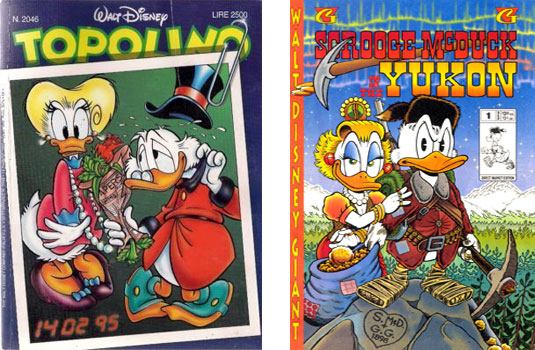
Goldie was a rival for Scrooge during his formative years in the Yukon. Over several seasons of hardship the two would grow to respect each other and more important to develop feelings for the other. Unfortunately both were too proud and stubborn to ever admit to those feelings. Scrooge left the Yukon behind and seemingly his heart as well. In flashbacks Scrooge would think fondly of his time spent up north. Goldie would always consider Scrooge the one that got away. This interesting dynamic left audiences wanting for closure to a relationship half a century in the making.
Adding superhero alter egos to established characters and creating new relationships within the canon were some of the major contributions by the Italians. One of the more controversial elements featured in the pages of Topolino, the inclusion of firearms in some of the stories, would have been a hard sell to American audiences, especially licensors and Disney stock holders. Many in the US would have never imagined seeing an icon like Mickey Mouse handling a weapon, let alone be threatened by one in a comic or cartoon.
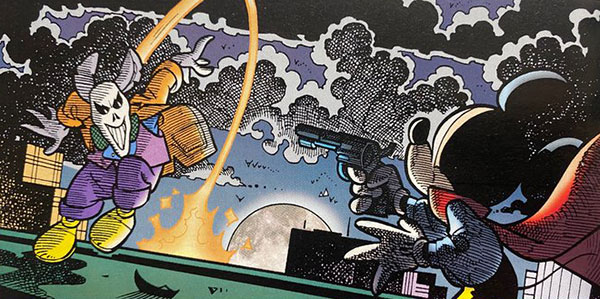
Yet guns had appeared for decades in Disney comics in the US and even animation. For example when Glittering Goldie wasn’t flirting with Scrooge she was shooting him with a shotgun. This happened in both the cartoon and comic books.
This revelation was not to say that weapons were commonplace in fumetti or other European Disney comics. If and when they showed up they fit the form of the story and certain mature themes. Paperino for example had an alter ego as a spy. In addition to being Paperinik Donald also had the responsibility as a spy for his country, known to fans as Double Duck. In the Double Duck (DD) stories sometimes a villain showed up carrying a weapon, sometimes DD had to also carry one along with his tuxedo ala James Bond. Very rarely did these comics have shoot outs and never were any of the characters depicted as getting shot or injured during the battles. The violence of the weapon was implied rather than shown. A gun served as a tool to intimidate not as an excuse by artists to draw graphic violence.
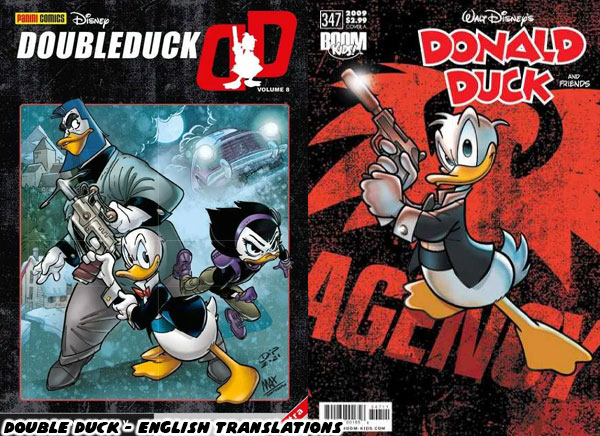
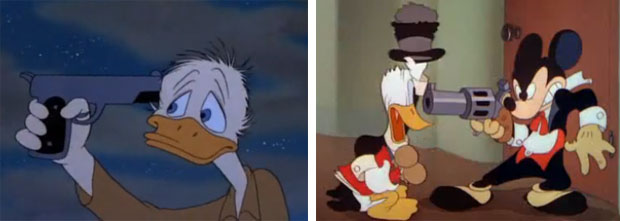
Disney Studios once used firearms in their animated projects and comics only now they seemed to shy away from any form or actual or implied violence. Topolino also used firearms but they certainly never put them flush to the temples of the icons as if they were in any real danger.
If Topolino and fumetti in general were geared only towards children then the writers and artists would certainly never have presented any weapons in the stories. At the same time they would never have produced as many memorable stories and adventures because of their audience. They would not have advanced the art of cartooning or showed how Disney comics could be written for every age.
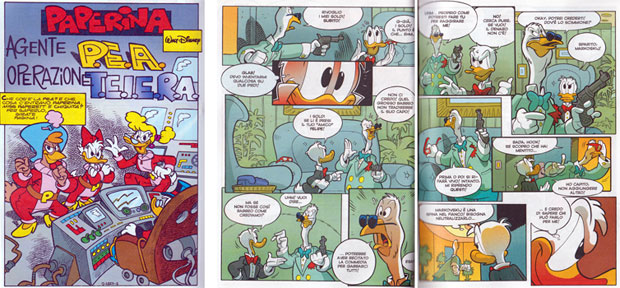
These were a few examples of the creative risks that the Italians took in the pages of Topolino. These were things that would not have been allowed if the comic were limited to a specific audience.
There was a major difference between how Disney was perceived and marketed in the USA versus Italy, or for that matter the rest of the world. Topolino was family entertainment. The comics and anthologies could be enjoyed by both kids and adults. Best of all the fumetti brought the characters to life. The Disney cartoon icons as well as original characters were featured in ongoing stories. These were certainly not reprints for aged collectors but living, breathing volumes. Not every Disney comic published in Europe was approached in the same way.
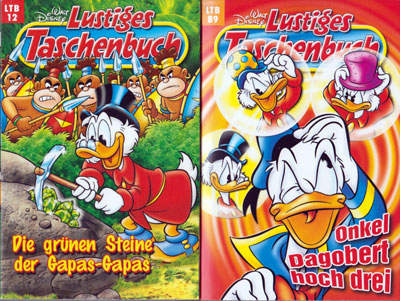
In Germany for example the anthologies featuring the Disney characters could be picked up in local bookstores. These simple 4-color books featured reprints or stories, most meant for kids with very little done in production value. Colors bled into each other and no sort of cleanup was done to enhance the original art. These issues were stale and formulaic when compared to the work featured in the fumetti.
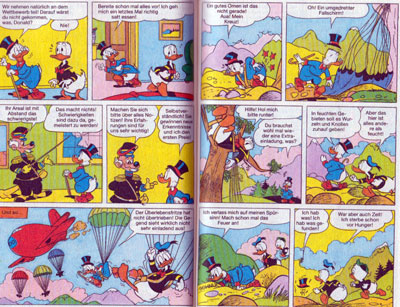
Other European countries did not settle for reprints. They were as passionate about the Disney comics and cartoons as anywhere else in the world. For example Donald Duck cartoons were viewed on Christmas Eve in Sweden as a tradition. Additionally fellow game writer Audun Sorlie mentioned how most stores in Scandinavia did not have a few Disney comics but instead had entire racks filled with the books.


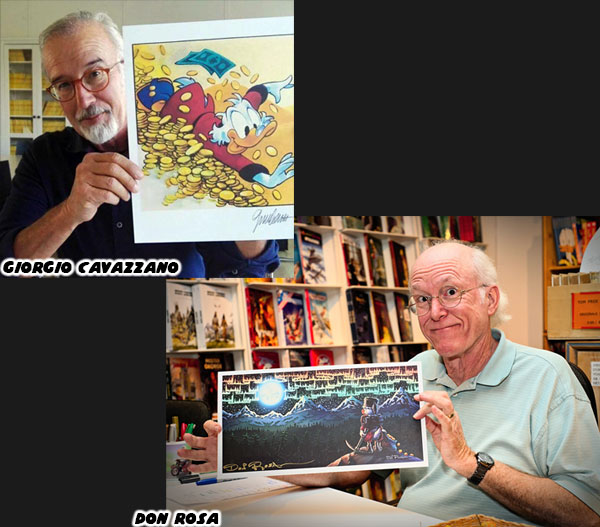
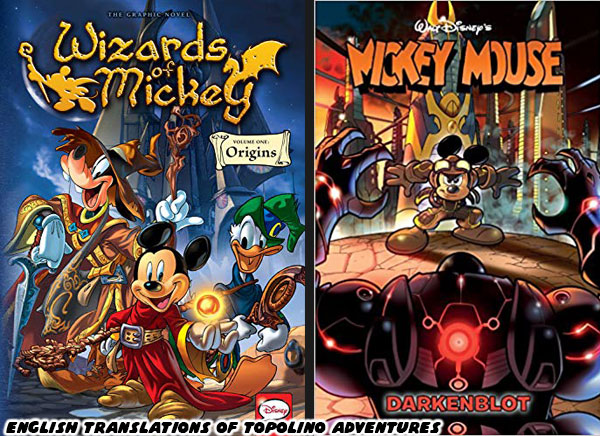
What is it about Topolio that makes the Disney characters accessible and relevant to audiences? A major part of it is having a monthly series dedicated to all of the characters written and drawn by some of the best creators in Europe. The publisher actually has a series of books dedicated to specific characters, trade paperbacks and even special hardcover editions for collectors. Like Marvel and DC in the US there are Topolino comics written for a very diverse audience. Unlike the comic book publishers in the USA the Topolino readers never feel left out because they missed a major event or story arc like Civil War or the New 52. The Disney characters are all familiar and although they might be set in the far future or fantasy setting audiences accept the story and situations at face value. They might be wizards in one story and then martial arts masters a month later, audiences never ask how or why this happened they simply enjoy the story.
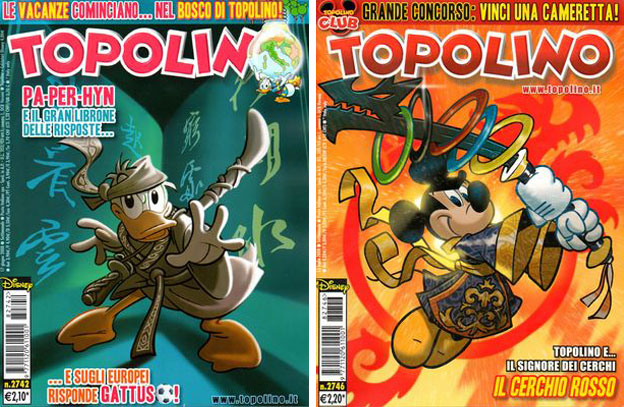
Comic books in the US are rooted in nonstop action, with sometimes violent or even frightening encounters for the heroes. Some of the Topolino stories keep pace with the Western traditions and place the Disney characters in peril month after month without creating a backlash from the community. Nowhere is this seen more than in the adventures of Double Duck. Casting Donald Duck as a super spy enables the character to be given a cadre of gadgets, and in rare cases a gun as well. He is sometimes joined by femme fatale Kay K while going on adventures that would make James Bond jealous.
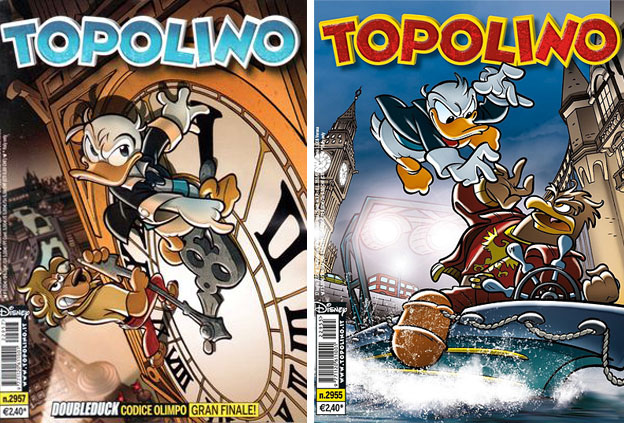
By making a familiar Disney character an action star it instantly makes Donald more appealing and accessible to adolescent audiences. Every genre explored in the pages of Topolino shows readers that the Disney characters can fill any role and be written for any age. Classic stories like Romeo and Juliet, Dr. Faustus and the Three Musketeers have all worked when cast with Disney mascots. The stories and characters do not have to be "dumbed down" for children, and in fact younger readers may be offended if they do not see their favorite characters act like real heroes in the face of adversity.
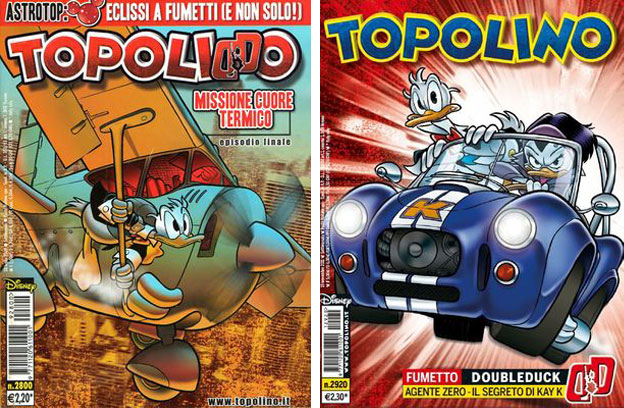
It might sound obvious that Disney in the US should follow the Italians if they want to make the mascots more relevant to audiences. The US would actually have a hard time localizing Topolino or even following the template. Topolino has been in publication for almost 80 years. In that time it has never dumbed down the writing or reduced the roles for and of the characters. If anything Topolino has actually done more for the personalities of the Disney mascots than the parent company has in the past 25 years. Unfortunately some people they could never, ever, accept a universe where the mascots handled firearms. The old comic books published in the US and even some of the old cartoons used to feature the characters as cops, robbers, soldiers and western heroes. They were allowed to have shoot outs so long as nobody got hurt or no blood was ever shown. This was how a cartoon like GI Joe got on the air during the 80's.
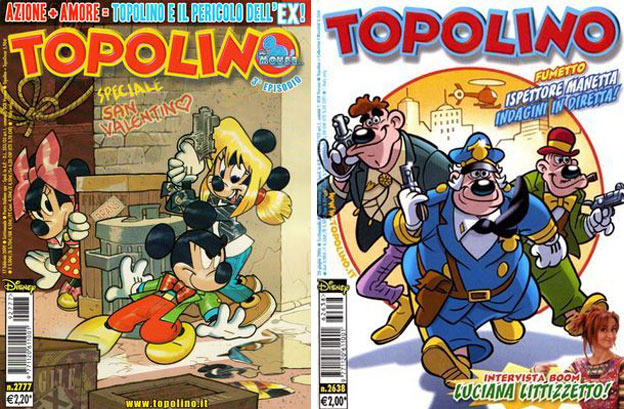
Public perception of how the characters can be used may be the biggest obstacle in making them relevant in the US. Purists would never imagine an acceptable story in which Mickey or his friends handled a gun. In fact purists would never imagine seeing the character have much of a personality at all. Mickey and his friends should never have too strong of a range of emotions. They should be constantly smiling and ever happy to many in the USA. Topolino has never dumbed down the characters or turned them into simplistic babysitters. Over the decades the comics have tackled a diversity of subjects and have never steered clear of even controversial ideas.
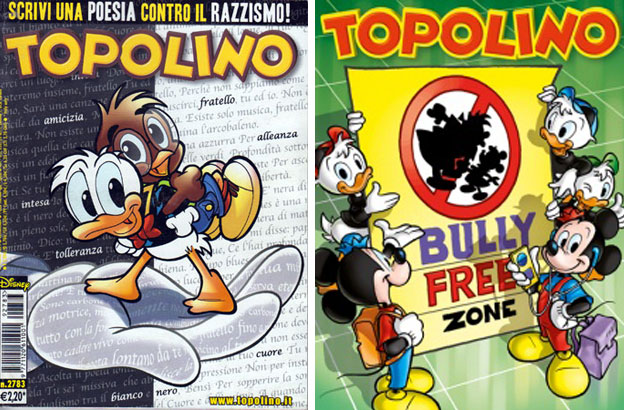
For example over the past decade some extremist fans of European football / soccer leagues had been the focus of sports media. Some clubs tolerated racist chants and iconography at matches. In a way to address this the comics talked about how friendships could be formed despite the differences of color. The books not only spoke out against racism they also let families know that they should speak up against discrimination. By aligning themselves with a progressive stance Disney was instilling very important values to their younger readers and earning the respect of older fans. Currently Topolino is running an anti-bully campaign. The stories teach ways to identify bullies and how to deal with them and what happens to people that are victims of bullying. The issues are able to communicate these ideas to young readers because the universe has many young characters they can identify with. Grade school characters Huey, Dewey, Louie and the slightly older Morty and Ferdie are very rarely seen in the US but are commonplace in Italy.
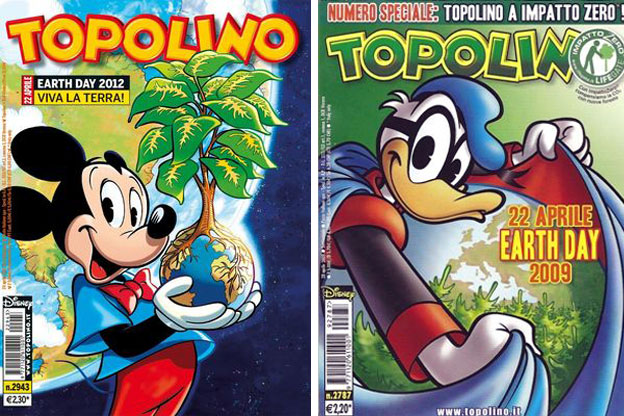
The comics in Italy go through a range of topics while managing to entertain as well. In one month they may have Donald Duck jumping out of an exploding helicopter and in the next he might be planting a tree in his backyard and teaching his nephews about conservation. Those that can get past the shock of seeing guns in the hands of cartoon icons would see that the books are not only well illustrated but also well written. Audiences identify with the mascot characters because they are written with distinct personalities. They are allowed to explore different genres and entertain readers at every level. Most important the comics are released month after month without exception. Movies and television shows may come and go but there was never a point where the Italians were without the Disney characters in print. Disney in the US could learn the importance of diligence from their overseas counterparts. As always if you would like to sponsor me please visit my Patreon page and consider donating each month, even as little as $1 would help make better blogs and even podcasts!
Good Monday morning my friends. I hope all is well on your side of town. To my friends on the East Coast, take care and I hope the hurricane loses steam quickly. Last week I was talking about how fans in the US were finding it harder to relate to the Disney mascot characters. Certainly the fans knew who they were and were familiar with their body of work, however they were also aware that they had not appeared in a new comic or cartoon in quite a long time. The most recognizable characters; Mickey, Minnie, Donald, Daisy, Goofy and Pluto appeared regularly on a show targeted for toddlers in the US. The Mickey Mouse Clubhouse held little interest to the older fans. Worse yet, the programming on the Disney and Disney XD channels did not feature any of the mascot cartoons either. When the Topolino comics overseas wanted to broaden their appeal they would introduce a new arc that made use of a bold storyline and was complimented with some fantastic art. One of the more recent entries fits in perfectly on Halloween week.
Dracula di Bram Topker was a retelling of the Dracula story by Bram Stoker. In this version the main players were all replaced by Disney characters. Mickey is playing Jonathan Ratker instead of Jonathan Harker. Instead of Professor Abraham Helsing the vampire hunter was played by Pippo Van Helsing (Pippo is the name of Goofy in Italy). Dracula was played by the Phantom Blot.
The writer, color artist team of Bruno Enna and Fabio Celoni did a fantastic version of the horror classic. The veteran artists did an amazing job at creating a gothic comic book style out of cartoon characters that would have made Mike Mignola (of Hellboy fame) proud.
The art was dazzling. The Italian cartoonists had been mentored by the Disney Academy. It is an art school set up by their publishing parents.
Those familiar with the story would find it kind of macabre yet interesting that Minnie Mouse and Clarabell Cow take on the roles of Mina and Lucy.
The violence was more implied than shown, same with the scares, even with that said it is doubtful that the story may ever be localized in the US given the subject matter.
It is truly a shame that more people in the US never get to see these comics. They have no idea how great the Disney comics and characters could be.
The friends and rivals to Mickey truly shine when creators are allowed to place them in wonderful stories. Month to month the readers of Topolino are reminded why Mickey is not only a friendly face but also synonymous with courage, loyalty and bravery. In the US that realization is slowly happening. Warren Spector and the group at Junction Point are steadily making Disney take notice of who Mickey is and what Mickey could be when faced with adversity. We'll look a little closer at the roots of Epic Mickey in the next blog. Until then see if you can track down a comic book shop that carries the recent comics by Boom Studios as well as the hardcover reprints of classic Disney stories by Fantagraphics. If you would like to sponsor me please visit my Patreon page and consider donating each month, even as little as $1 would help make better blogs and even podcasts!